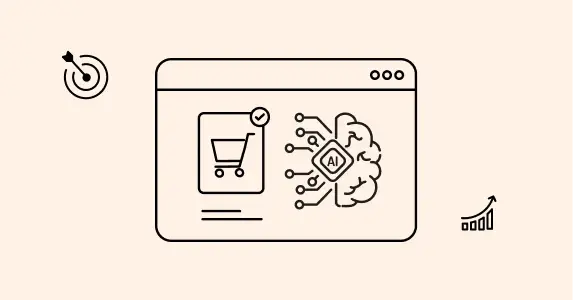As we move through 2025, tariffs are becoming the most disruptive economic force in ecommerce & retail. The situation is not ideal: Gartner’s Q1 2025 analysis highlights US tariffs reaching levels of 54% on goods from critical trading partners, such as China, which impacts a staggering $463 billion in annual exports to the US from that country alone. While headlines have focused on inflation and interest rates, it’s these structural cost shifts from new trade policies that are forcing retailers to rethink everything from merchandising to fulfillment.
These tariffs are simply government-imposed taxes on imported goods for retailers, which means a significant increase in landed costs—the total cost of bringing goods into the country, including duties, shipping, and taxes.
Example: If a $100 smartwatch now carries a 15% tariff, its import cost rises to $115. If that smartwatch was sold for $150, the margin just shrank — unless the pricing strategy, supply chain, or marketing approach adapts, you’ll make less money than before.
Analyzing Tariff Impact on Your Business and Consumers
The impact of tariffs is rarely felt uniformly. Brands with global sourcing and thin margins will feel the pressure more acutely than vertically integrated or domestic manufacturers.
But the pain points often show up late, when existing inventory is sold through and newer, pricier inventory hits the shelves. Retailers must assess which SKUs will be affected, identify which suppliers are at risk, and determine how these changes will impact price elasticity across different segments.
For consumers, the effects of Tariffs have already been felt. In March, categories like motor vehicles and sporting goods saw brief spending surges — consumers rushing to beat the tariff hikes. But this bump was deceptive. By April, the University of Michigan’s Consumer Sentiment Index had dropped to 50.8 — its lowest point since the Great Recession.
Strategies to Mitigate Tariff Costs
1. Pricing Strategies: Adjusting Prices Without Alienating Shoppers
Raising prices in response to tariffs isn’t optional — but how you do it matters. Flat hikes across categories risk alienating loyal shoppers, especially in a price-sensitive market. Instead, retailers should take a category-by-category and SKU-level approach, weighing which products can support a price increase without harming conversion. Products with strong brand affinity, limited substitutes, or high perceived value can often bear modest increases more easily.
In parallel, consider offering flexible pricing options, such as installment plans, loyalty point redemptions, or even delayed shipping in exchange for discounts. Transparency also goes a long way: many customers understand the impact of tariffs when it’s explained clearly and honestly. When retailers frame increases as part of a broader effort to maintain product quality and service levels, shoppers are more likely to respond with trust than resistance.
2. Supply Chain Adjustments
Rethink your sourcing strategy. Can specific components or SKUs be nearshored to reduce duties? Are there suppliers in tariff-exempt countries offering comparable quality? Explore dual sourcing models to hedge against future tariff hikes. Consider renegotiating logistics contracts or investing in fulfillment nodes closer to major markets to reduce shipping costs.
Tariffs might be unavoidable, but relying on a single source or region magnifies their risk. Supply chain agility is now a core competency, not just an operational bonus.
Marketing Techniques That Protect Margin and Perception
3. Product Pairings
When cost pressures rise, promotional strategies shouldn’t just be about slashing prices — they should be about increasing perceived value. Bundling tariff-impacted products with non-impacted or domestic SKUs can help maintain margins while enhancing basket size. Furthermore, leveraging targeted cross-sell and up-sell recommendations can further amplify value perception and guide shoppers towards complementary or enhanced product sets.
You must think in terms of convenience, lifestyle pairing, and problem-solving offers that shift the shopper’s focus from price to utility.
Wise bundling also improves logistics economics, as shipping multiple items together reduces the cost per unit.
4. Smarter Segmentation to Retain Revenue
In an environment of fluctuating cost pressures, understanding and acting upon varying price sensitivities across your customer base is paramount for revenue retention.
Blanket strategies are inefficient; intelligent audience segmentation is henceforth non-negotiable.
Low-sensitivity/High-Value: Identify shoppers who are less concerned with price (often brand loyal). Focus on loyalty perks and value-adds over deep discounts to preserve margins.
High-sensitivity: Target price-conscious segments with relevant promotions or suggest appropriate, tariff-free alternatives based on their known product affinities to prevent churn.
Product/Category Level: Analyze sensitivity and affinity across product lines and brands, as tolerance for price changes varies.
Tailored Action: Use this granular understanding to shape all merchandising, messaging, and offers, emphasizing value for low-sensitivity, high-affinity groups and savings or alternatives for high-sensitivity ones.
5. Better Merchandising & On-Site Search
Tariffs compress margins — so promote products that protect them. Merchandising should no longer be static. Retailers need dynamic systems that prioritize the most profitable SKUs. It’s about re-ranking category listings, featured collections, and even internal search results to align with financial priorities.
The same applies across channels: the products you recommend via email, app, or push notifications should reflect your new cost structures, not just what’s trending.
6. Adopting AI to Optimize Marketing Spend
AI isn’t just for product recommendations or chatbots anymore. It can now play a central role in optimizing marketing efficiency. Predictive AI can forecast which customer segments are most likely to churn, allowing you to shift tactics in real time. AI can also help reduce dependency by revealing which channels drive actual incremental lift versus those that don’t.
As marketing budgets come under pressure, AI becomes the compass for leaner, more innovative, more adaptive campaigns.
7. Doubling Down on Owned Channels
Email, RCS, push notifications on web and app, and on-site search experiences are high-impact avenues, especially when customer acquisition costs (CAC) from paid channels are spiking. Retailers who have historically focused on acquisition must now master retention through intelligent, cross-channel marketing. Owned channels allow for lower costs compared to siloed SaaS counterparts, streamlined processes, and less downtime.
From Shock to A Strategic Reset
Tariffs aren’t just a policy change — they’re a retail stress test. They expose brittle pricing strategies, rigid supply chains, and over-reliance on paid media. But for brands willing to adapt, they also offer a rare opportunity: to redesign operations, deepen customer relationships, and emerge more resilient.
In 2025, protecting growth isn’t about avoiding costs — it’s about absorbing them strategically, through smarter pricing, marketing, and systems.
Netcore helps future-ready retailers turn marketing systems into strategic margin protectors — not just message broadcasters.
 Holiday Sales Are Won Now — Grab the 2025 Holiday Marketing Guide to Unlock More Revenue.
Holiday Sales Are Won Now — Grab the 2025 Holiday Marketing Guide to Unlock More Revenue. 












